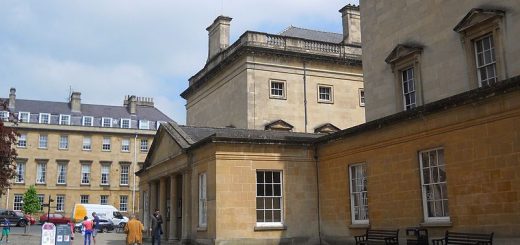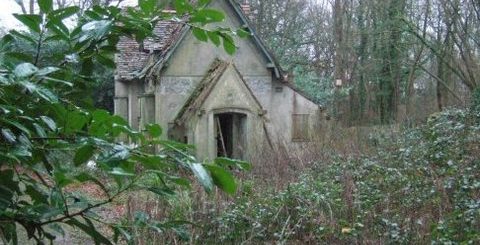27 Upper Baker Street
The famous 18th century actress Sarah Siddons (born 5 July 1755) bought 27 Upper Baker Street in 1817 and it was here that she died on 8 June 1831. Because of its connections with Sarah, in 1876 the house became the first building to receive a nationally recognised memorial plaque for a woman. Though the house was demolished in 1904, it is reputed that Mrs Siddons apparition haunts the building that replaced it, an electrical substation at 228 Baker Street.
 Sarah retired from the stage in 1812, just a few years before buying 27 Upper Baker Street. Upper Baker Street was the original name for Baker Street and it was known as such even when the first stories of its most famous fictional resident, Sherlock Holmes were written. In 1904, whilst the house was being demolished, an article concerning 27 Upper Baker Street entitled The “Tragic Muse” appeared in the Otago Witness (a New Zealand newspaper that ran between 1851 – 1932).
Sarah retired from the stage in 1812, just a few years before buying 27 Upper Baker Street. Upper Baker Street was the original name for Baker Street and it was known as such even when the first stories of its most famous fictional resident, Sherlock Holmes were written. In 1904, whilst the house was being demolished, an article concerning 27 Upper Baker Street entitled The “Tragic Muse” appeared in the Otago Witness (a New Zealand newspaper that ran between 1851 – 1932).
‘Railway extension has caused the disappearance of many old landmarks, and it now claims the ground on which stands No. 27, Upper Baker Street, a house round which cluster many memories of the London stage. It was here that Mrs Siddons retired to rural peace and quietude from her triumphs on the boards. She bought the house, then almost the last in London, and built a big bow window from which she could look over the green fields and hawthorn-bowered lanes which stretched away towards Finchley. And here the last 15 years of her life were spent, pleasantly enough.
She had realised a handsome fortune, and had made many friends. The memoirs of the time are full of references to the “Tragic Muse” as she loved to be styled. Washington Irving tells how he would walk to Baker street to hear her read passages from Shakespeare in that voice of “thunderous music” by which she had been used to hold the crowded houses spellbound.
‘Sir Thomas Lawrence (painter, born13 April 1769 – died 7 January 1830), Sir Joshua Reynolds*, Sheridan Fox and half the wits and beaux of the town would gather in those ugly square rooms now given over to the housebreaker’s men. Lovely Lady Sarah Lennox and another Duke’s daughter no less lovely, Lady Charlotte Campbell, were constantly there. Prince Leopold of Saxe-Coburg, afterwards King of the Belgians, lived hard by at St. John’s Lodge, then a house lost I the fields out of which the newly-planned Regent’s Park was being made. Prince Leopold, in the first desolation of his widowhood, found relief in the never-failing sympathy of the large hearted woman who had kept her own soul unsoiled through all the stress and strain of her busy life.
Great tragedy queen as she was, she found time to be one of the best housewives, one of the most devoted mothers in England. Little children never feared her, although the greatest men in the kingdom did!
It is we think Lady Louisa Stuart who tells of Mrs Siddons indignation when the building of Cornwall Terrace threatened to obstruct her view from the windows of No.27. Full of superb wrath, the lady went straight to the Prince Regent himself, who was graciously pleased to command that bricks and mortar were not to be allowed to annoy the ”Tragic Muse”. What would the great actress say could she behold her old home now, and the flood of brick and mortar which has banished the Marylebone milkmaids for ever?’
Sarah siddons most famous role was Lady MacBeth and the painter Ilaydon described a reading Sarah gave of MacBeth at her home in 27 Upper Baker Street on 10 March 1821. “It is extraordinary the awe this wonderful woman inspires. After her first reading the men retired to tea. While we were all eating toast, and tingling cups and saucers, she began again …. all noise ceased. We slunk to our seats like boors, two or three of the most distinguished men of the day, with the very toast in their mouths, afraid to bite. It was curious to see Lawrence (Sir Thomas Lawrence) in this predicament, to hear him bite by degrees, and then stop for fear of making too much crackle, his eyes full of water from the constraint, and at the same time to hear Mrs. Siddons, ” eye of newt, and toe of frog,” and then to see Lawrence give a sly bite, and then look awed, and pretend to be listening. I went away highly gratified, and as I stood on the landing-place to get cool, I overheard my own servant in the hall say, ” What, is that the old lady making such a noise?” “Yes.” “Where she makes as much noise as ever.” “Yes,” was the answer,” she tunes her pipes as well as ever she did.”
Wilmot Harrison in Memorable Houses mentions the above account, and also goes on to mention that ‘Washington Irving was among Mrs. Siddons’s visitors, and refers to having “heard her read Constance at her house one evening.” Fanny Barney describes Mrs. Siddons as “in face and person truly noble and commanding, in manner quiet and stiff, in voice deep and dragging, in conversation formal, sententious, calm and dry.” “She was a grand artist,” writes Mr. Barton Baker, “but a very disagreeable woman.” Instances of haughtiness and insolence are not wanting, and she possessed in a high degree the failings of the Kembles** generally — avarice, and the lack of charitableness which is its natural product.’
Ghost:
The apparition of Sarah Siddons is said to glide through the first floor walls of 228 Baker Street, stands where 27 Upper Baker Street stood until 1904. It is worth noting that Sarah Siddons is reputed to haunt the Bristol Old Vic and the Sarah Siddons School on North Wharf Road.
* The painter Sir Joshua Reynolds actually died on 23 February 1792, so he could not have visited Sarah at 27 Upper Baker Street.
** Sarah’s maiden name was Kemble and she was born in Brecon, Wales. The Kembles were a well known theatrical family,her father Roger Kemble was an actor manager and her brothers and sisters John Philip Kemble, Charles Kemble, Stephen Kemble, Ann Hatton (Ann of Swansea) and Elizabeth Whitlock were also actors.




Re: 27 Upper Baker Street
Quite an interesting info-I knew nothing about this although I visited the area-Regent’s Park. Holmes’s House. It is one of my favourite parks in the area.